In Photos: The Sun's Monster X9.3 Solar Flare of Sept. 6, 2017
Massive Flare
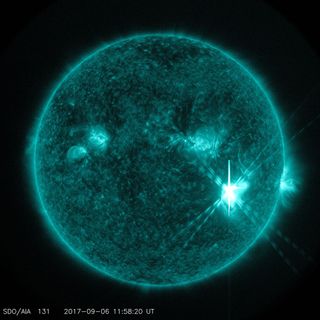
On Sept. 6, 2017, a giant sunspot on the sun erupted with a colossal solar flare that registered X9.3 on the solar storm scale. See photos of the massive flare, and its solar aftershocks, in our gallery here.
The Solar Dynamics Observatory captured this image in 131 angstrom wavelength. SDO is one of many spacecraft that constantly monitor the sun for signs of space weather events.
Large Flash
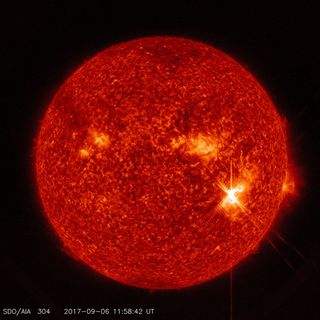
At 305 angstrom wavelength, the sun presents in a red orange with the monstrous flare flowing on the lower right side in this SDO image. X-class flares are the strongest class of solar storms the sun can experience.
High Class

The X9.3 class flare glitters in this image from NASA's SDO showing the sun in a deep yellow at 171 angstrom wavelength.
Double Duty
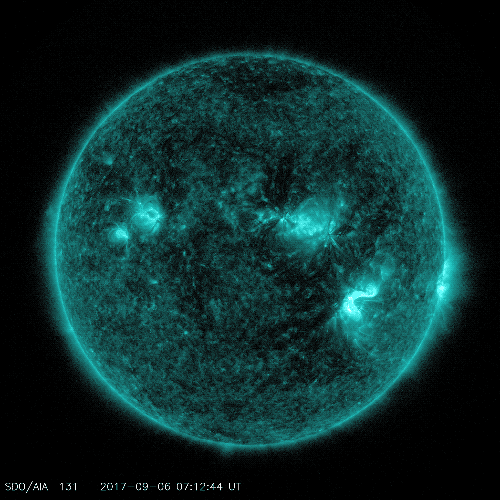
This animation of the sun on Sept. 6, 2017, displays the X2.2 and X9.3 flares radiating outward. The flares erupted from an extremely active sunspots, known as Active Regions 2673 and 2674.
Sunspots Sept. 6 by SDO
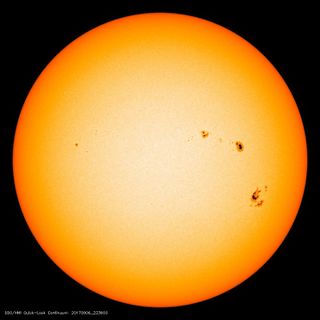
Two large sunspots are visible on the right side of the sun in this image taken by NASA's Solar Dynamics Observatory on Sept. 6, 2017.
Sunspots Sept. 6
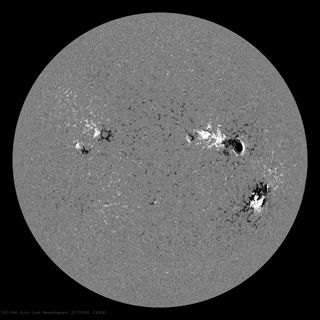
Two large sunspots are visible on the right side of the sun, in this image taken by the Helioseismic and Magnetic Imager (HMI) on NASA's Solar Dynamics Observatory, which shows magnetic activity on the star's surface. The image was taken on Sept. 6, 2017.
Get the Space.com Newsletter
Breaking space news, the latest updates on rocket launches, skywatching events and more!
Lighted Image

Using both visible and 304 angstrom extreme ultraviolet wavelengths, both sunspots on the surface and the flare in the sun's atmosphere are clear.
Sunspots Glow

Blending together 171 and 131 angstrom light wavelengths, NASA's Solar Dynamics Observatory created this image exhibiting the X9.3 class solar flare.
A Closer Look
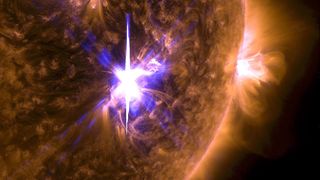
In this close up view, the X9.3 class solar flare pierces through the rest of the light from the sun.
Perspectives

This image from the SDO shows a combination of views of the X9.3 solar flare. On the left a blend of 131 and 171 angstrom light is shown and on the right both visible and 304 angstrom extreme ultraviolet wavelengths are shown. The righthand image clearly shows the flare in the solar atmosphere as well.
Showing Off

The sunspot responsible for the X9.3 solar flare did show some early signs of its power. On Sept. 4, 2017, the M5.5 class solar flare, shown in 131 angstrom wavelength, flashes near the center of our giant star.
Join our Space Forums to keep talking space on the latest missions, night sky and more! And if you have a news tip, correction or comment, let us know at: community@space.com.

Christine Lunsford joined the Space.com team in 2010 as a freelance producer and later became a contributing writer, covering astrophotography images, astronomy photos and amazing space galleries and more. During her more than 10 years with Space.com, oversaw the site's monthly skywatching updates and produced overnight features and stories on the latest space discoveries. She enjoys learning about subjects of all kinds.
